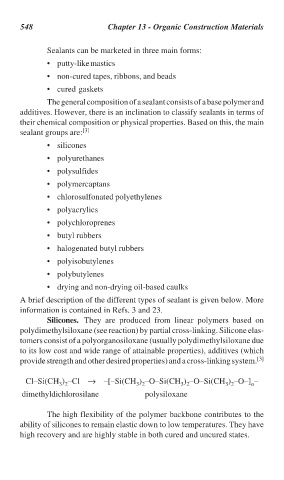Page 578 - Handbook of Thermal Analysis of Construction Materials
P. 578
548 Chapter 13 - Organic Construction Materials
Sealants can be marketed in three main forms:
• putty-like mastics
• non-cured tapes, ribbons, and beads
• cured gaskets
The general composition of a sealant consists of a base polymer and
additives. However, there is an inclination to classify sealants in terms of
their chemical composition or physical properties. Based on this, the main
sealant groups are: [3]
• silicones
• polyurethanes
• polysulfides
• polymercaptans
• chlorosulfonated polyethylenes
• polyacrylics
• polychloroprenes
• butyl rubbers
• halogenated butyl rubbers
• polyisobutylenes
• polybutylenes
• drying and non-drying oil-based caulks
A brief description of the different types of sealant is given below. More
information is contained in Refs. 3 and 23.
Silicones. They are produced from linear polymers based on
polydimethylsiloxane (see reaction) by partial cross-linking. Silicone elas-
tomers consist of a polyorganosiloxane (usually polydimethylsiloxane due
to its low cost and wide range of attainable properties), additives (which
provide strength and other desired properties) and a cross-linking system. [3]
Cl–Si(CH ) –Cl → –[–Si(CH ) –O–Si(CH ) –O–Si(CH ) –O–] –
3 2 3 2 3 2 3 2 n
dimethyldichlorosilane polysiloxane
The high flexibility of the polymer backbone contributes to the
ability of silicones to remain elastic down to low temperatures. They have
high recovery and are highly stable in both cured and uncured states.

